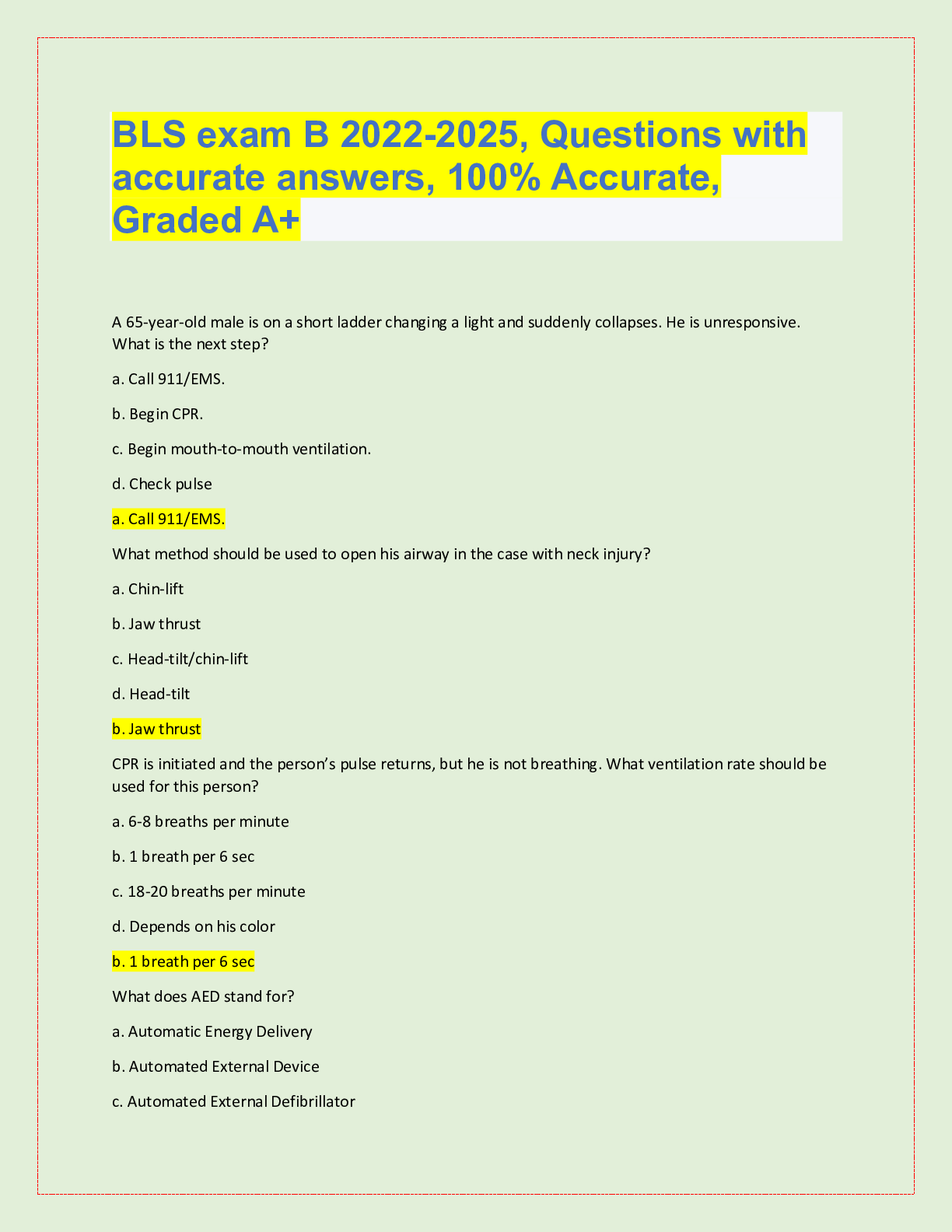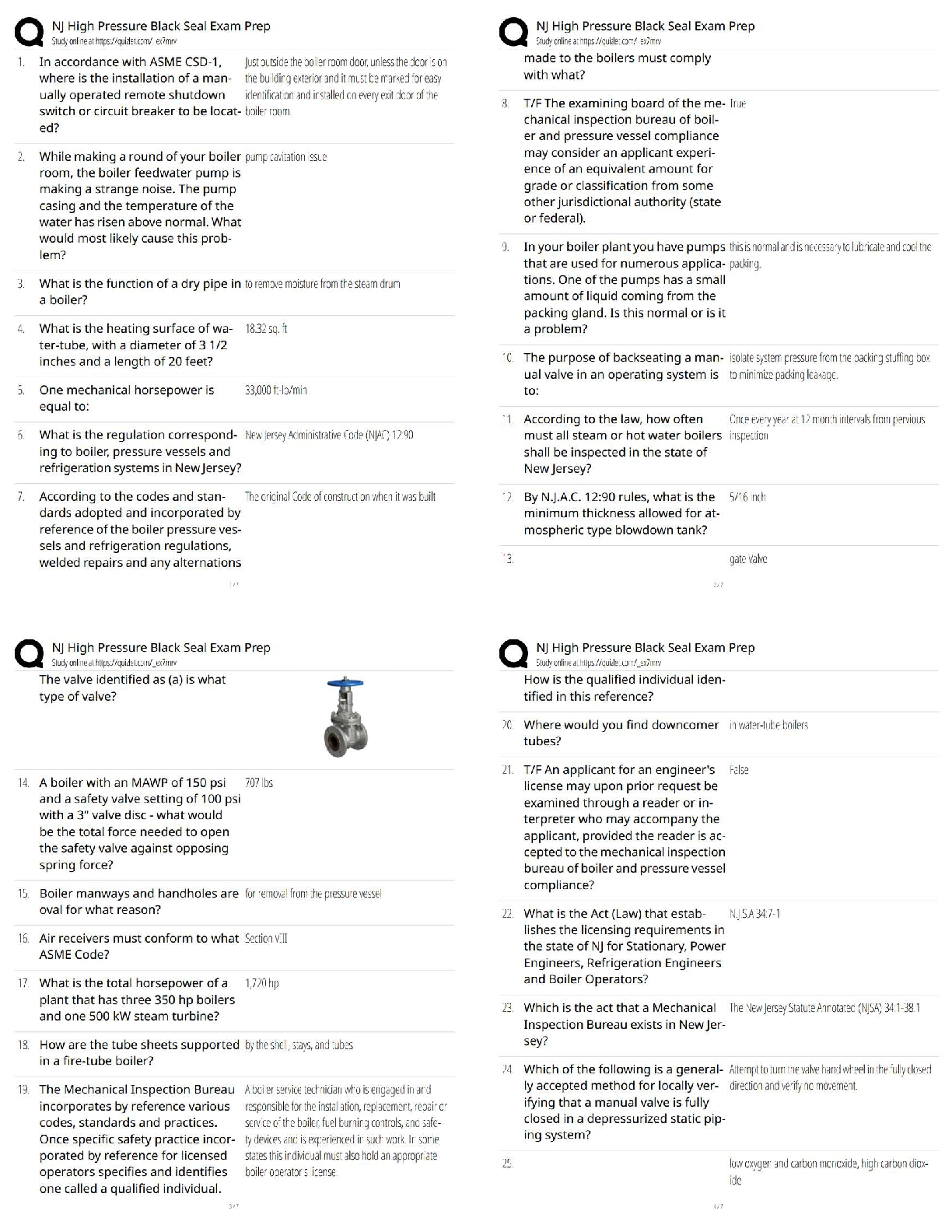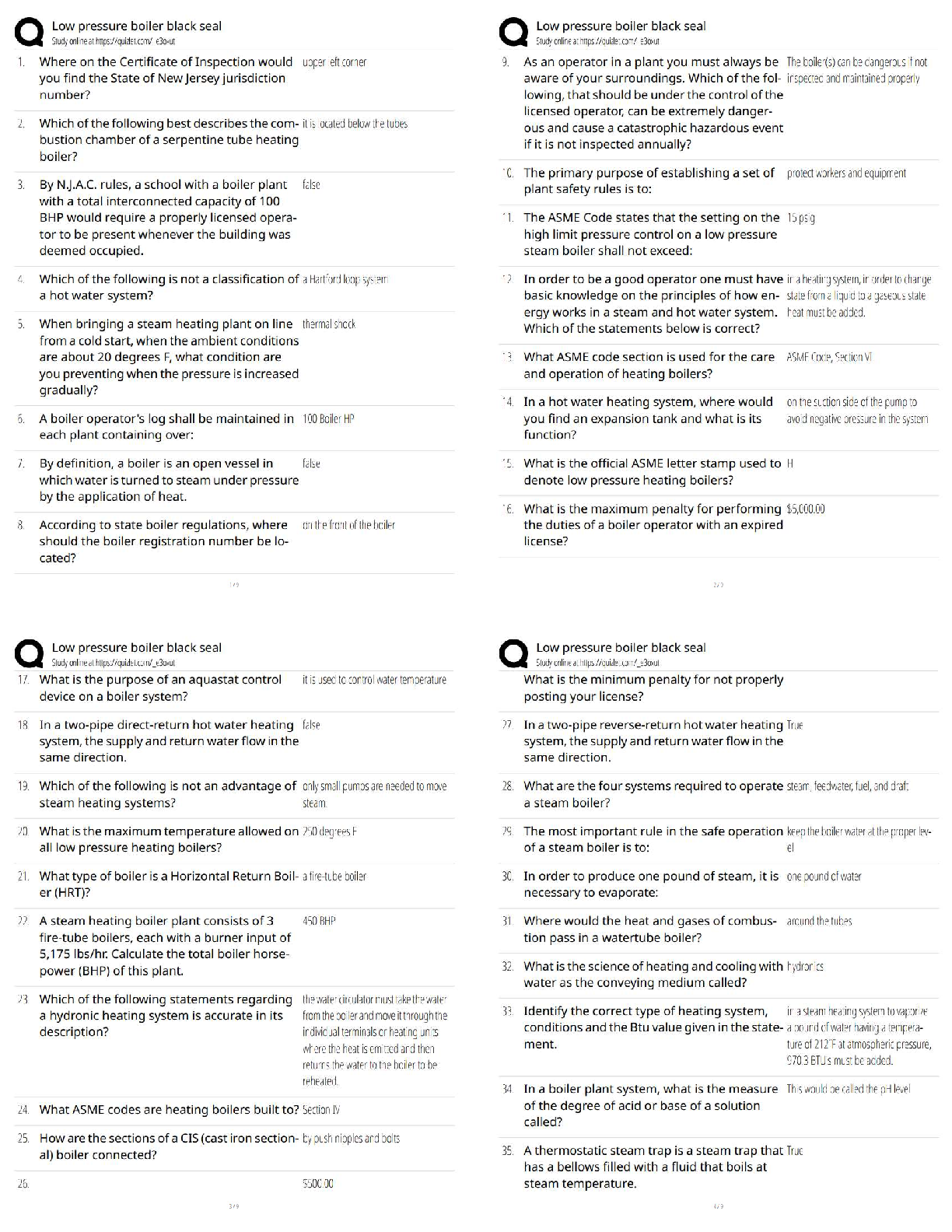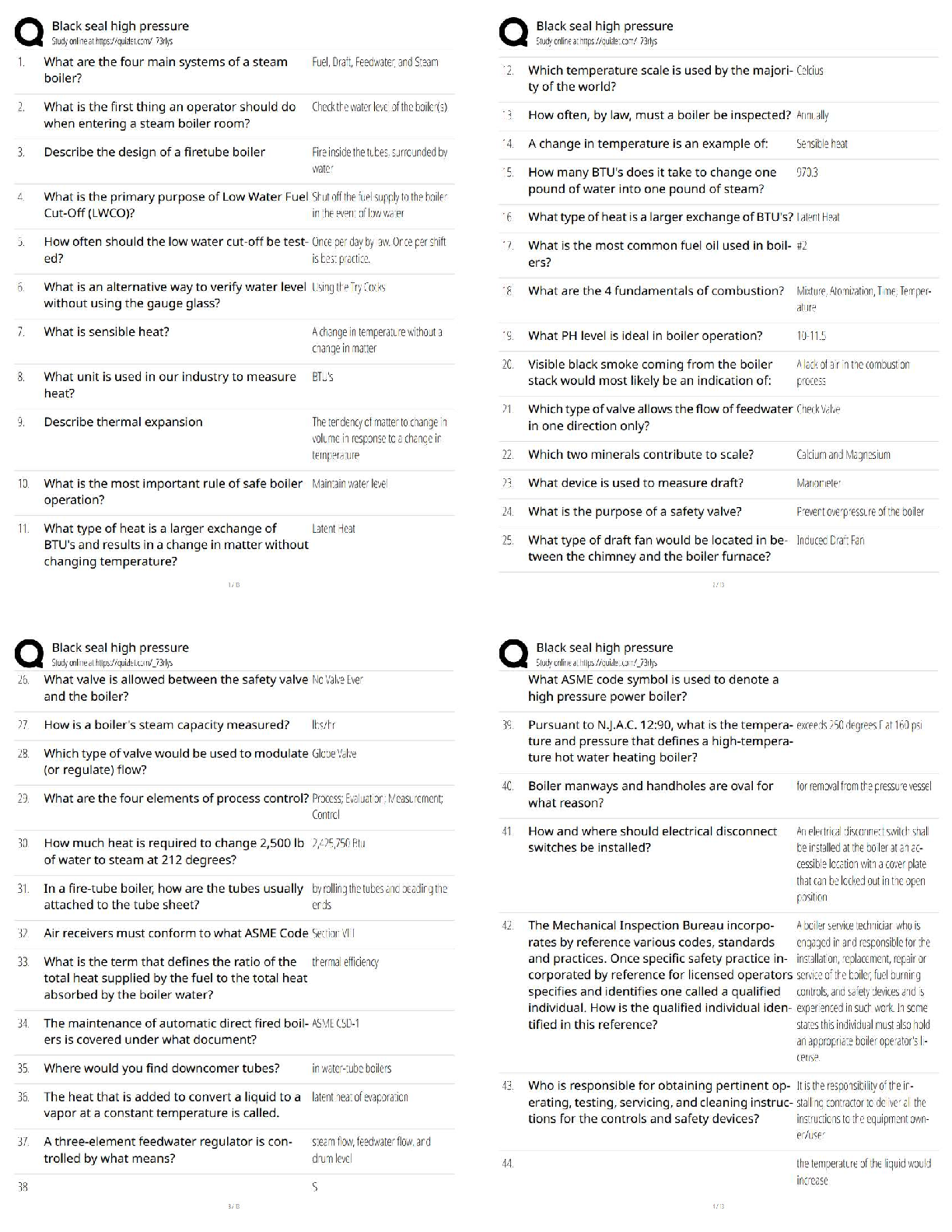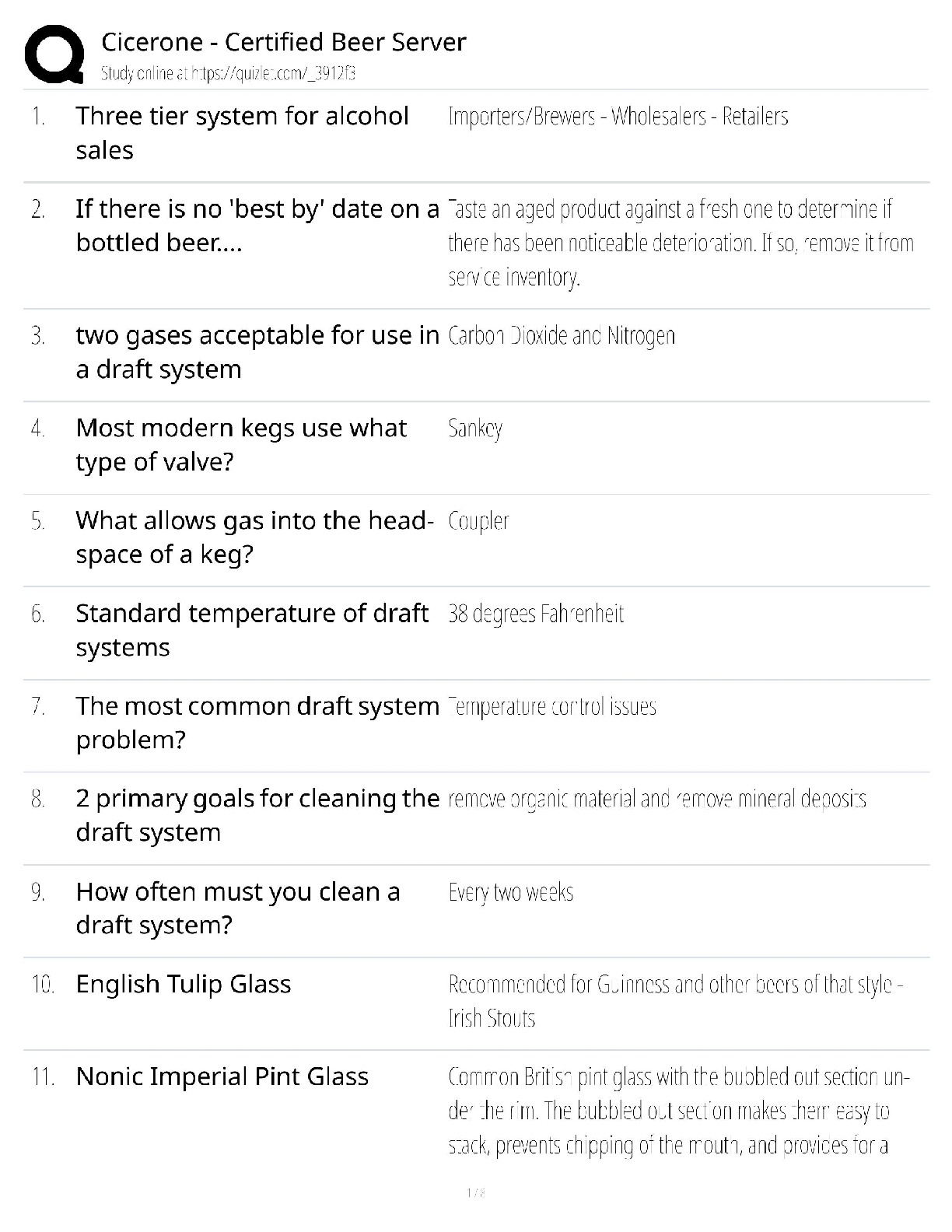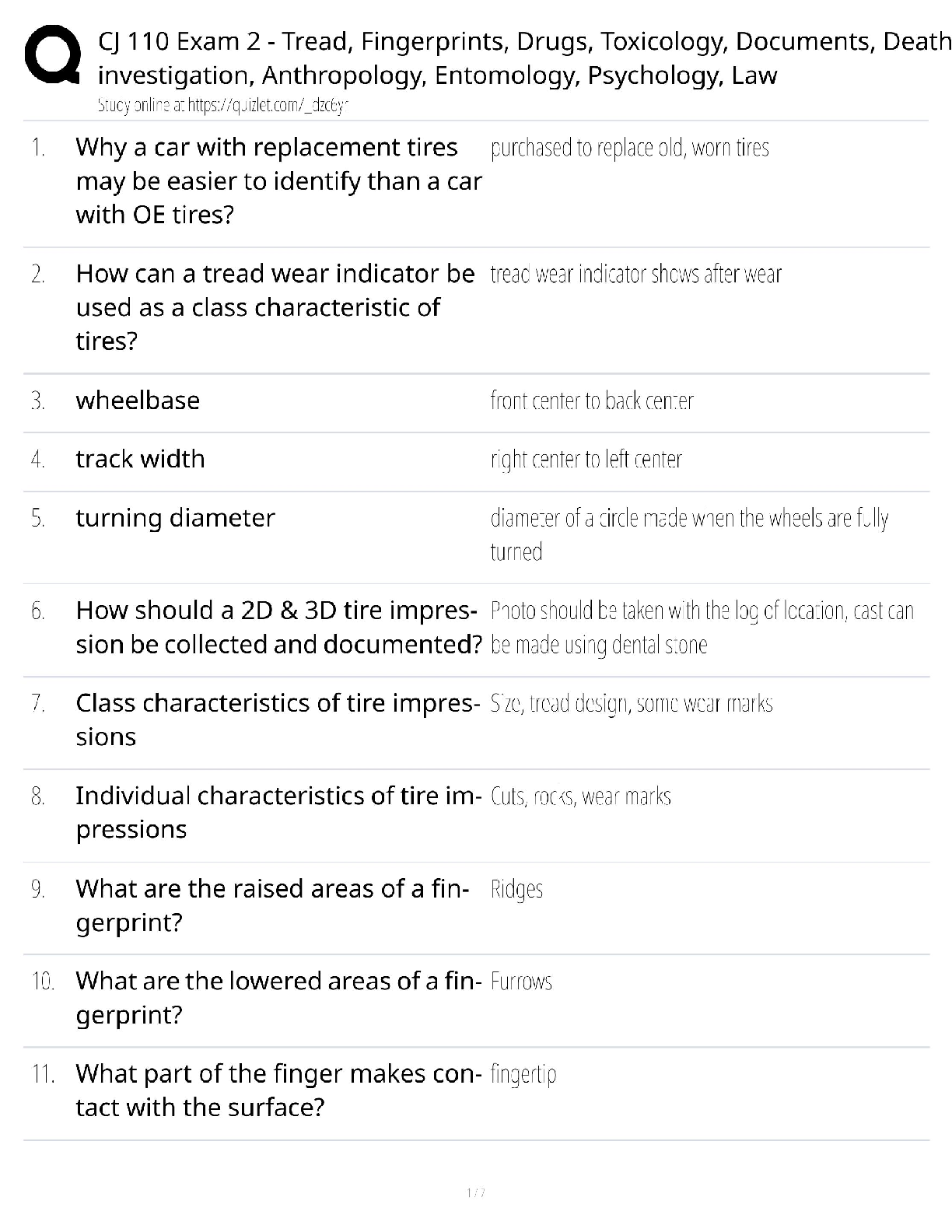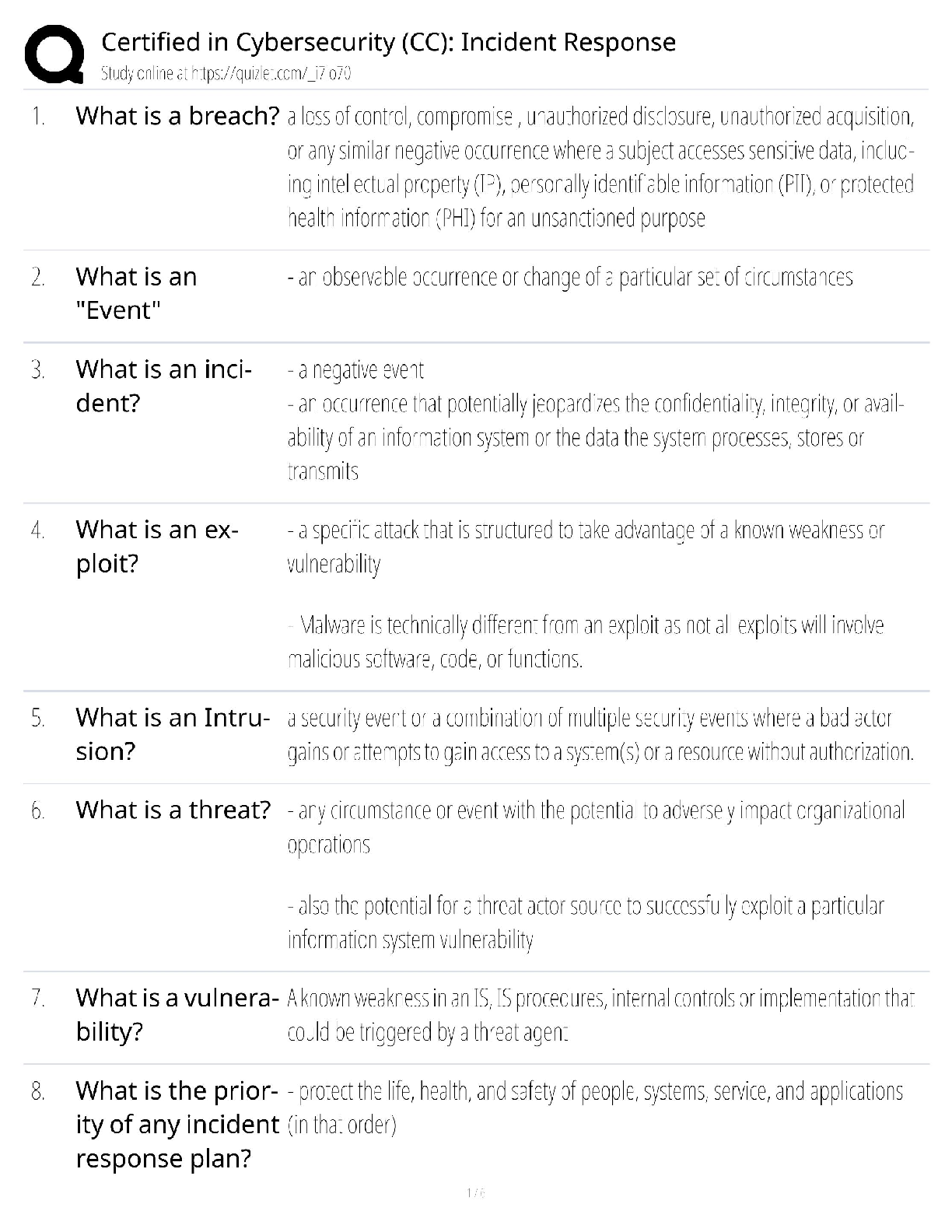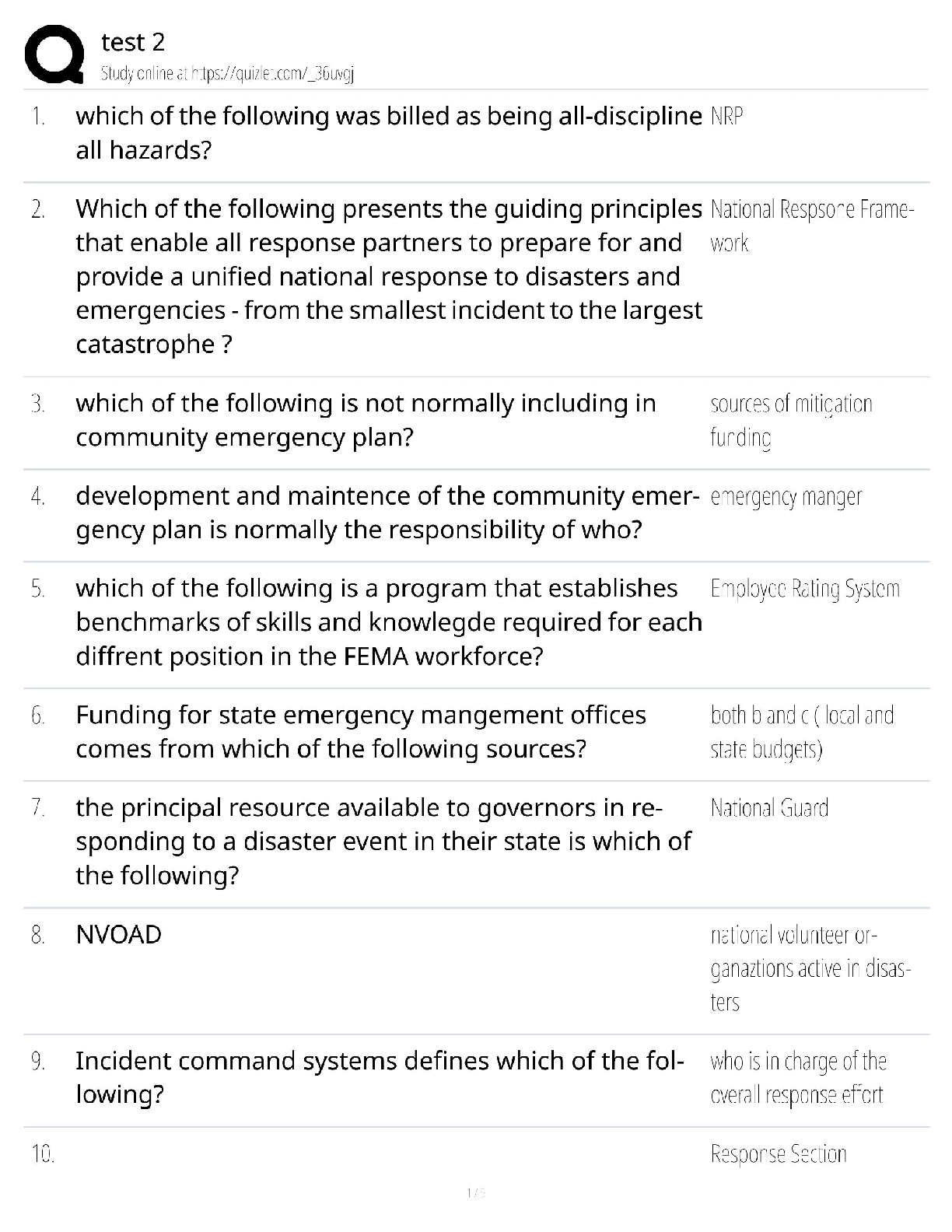*NURSING > QUESTIONS & ANSWERS > ACE CPT Combined Sets. TEST BANK. 100% Examinable. Full Coverage. COMPREHENSIVE (All)
ACE CPT Combined Sets. TEST BANK. 100% Examinable. Full Coverage. COMPREHENSIVE
Document Content and Description Below
ACE CPT Combined Sets. TEST BANK. 100% Examinable. Full Coverage. COMPREHENSIVE anatomical position - ✔✔-standing erect with the feet and palms facings forward connective tissues - ✔✔-ti ... ssue that binds together and supports various structures of the body; ligaments and tendons epithelial tissue - ✔✔-tissue that covers the surface of the body and lines the body cavities, ducts, and vessels digestion - ✔✔-process of breaking down food into small enough units for absorption absorption - ✔✔-uptake of nutrients across a tissue or membrane by the gastrointestinal tract esophagus - ✔✔-food pipe; conduit from the mouth to the stomach arteries - ✔✔-blood vessels that carry oxygenated blood away from the heart to vital organs and the extremities capillaries - ✔✔-smallest blood vessels that supply blood to the tissues, and the site of all gas and nutrient exchange in the cardiovascular system; connect arterial and venous systems veins - ✔✔-blood vessels that carry deoxygenated blood toward the heart from vital organs and the extremities plasma - ✔✔-liquid portion of the blood hormones - ✔✔-chemical substance produced and released by an endocrine gland and transported through the blood to a target organ ions - ✔✔-single atom or small molecule containing a net positive or negative charge due to an excess of either protons (positive) or electrons (negative) platelets - ✔✔-disc-shaped components of the blood; involved in clotting arterioles - ✔✔-small diameter blood vessels that extend and branch out from an artery and lead to capillaries; the primary site of vascular resistance venules - ✔✔-smaller divisions of veins aorta - ✔✔-major artery of the cardiovascular system; arises from the left ventricle of the heart arteriosclerosis - ✔✔-chronic disease in which thickening, hardening, and loss of elasticity of the arterial walls result in impaired blood circulation; develops with aging, and in hypertension, diabetes, hyperlipidemia, and other conditions interstitial fluid - ✔✔-fluid between the cells or body parts ventricles - ✔✔-two lower chambers of the heart atrium - ✔✔-upper chambers of the heart pulmonary circuit - ✔✔-circulatory vessels of the lungs; involved in the circulation of blood from the right ventricle of the heart to the lungs and back to the left atrium of the heart systemic circuit - ✔✔-circulatory vessels of the body cardiac cycle - ✔✔-period from the beginning of one heart beat to the beginning of the next heartbeat; the systolic and diastolic phases and the interval in between systole - ✔✔-contraction phase of the cardiac cycle diastole - ✔✔-period filling of the heart between contractions; resting phase of the heart pharynx - ✔✔-muscular, membranous tube extending from the base of the skull to the esophagus larynx - ✔✔-organ of the voice; located between the trachea and the base of the tongue trachea - ✔✔-cartilaginous and membranous tube extending from the larynx to the bronchi; windpipe bronchi - ✔✔-two large branches of the trachea leading into the lungs alveoli - ✔✔-spherical extensions of the respiratory bronchioles and the primary sites of gas exchange with the blood bronchioles - ✔✔-smallest tubes that supply air to the alveoli (air sacs) of the lungs thorax - ✔✔-portion of the trunk above the diaphragm and below the neck expiration - ✔✔-act of expelling air from the lungs; exhalation gastrointestinal tract - ✔✔-long hollow tube from the mouth to anus where digestion and absorption occur chemical digestion - ✔✔-form of digestion that involves the addition of enzymes that break down nutrients lymphatic system - ✔✔-network of lymphoid organs, lymph nodes, lymph ducts, lymphatic tissues, lymph capillaries, and lymph vessels that produces and transports lymph fluid from tissues to the circulatory system epiglottis - ✔✔-cartilage in the throat that guards the entrance to the trachea and prevents fluid or food from entering it during the act of swallowing bolus - ✔✔-food and saliva digestive mix that is swallowed and then moved through the digestive tract peristalsis - ✔✔-process by which muscles in the esophagus and intestines push food through the gastrointestinal tract in a wave-like motion cardiac sphincter - ✔✔-sits at the upper portion of the stomach; prevents food and stomach acid from splashing back into the esophagus from the stomach; also called the esophageal sphincter chyme - ✔✔-semiliquid mass of partly digested food expelled by the stomach into the duodenum pyloric sphincter - ✔✔-separates the stomach from the small intestines duodenum - ✔✔-top portion of the small intestine bile - ✔✔-greenish-yellow or brownish emulsifier that prepares fats and oils for digestion; produced in and secreted by the liver, stored in the gallbladder, and released into the small intestine villi - ✔✔-finger-like projections from the folds of the small intestins microvilli - ✔✔-tiny hairlike projections on each cell of every villus that can trap nutrient particles and transport them into the cells for absorption colon - ✔✔-lower portion of the large intestine, the primary function of which is to absorb water electrolytes - ✔✔-mineral that exists as a charged ion in the body and that is extremely important for normal cellular function glucose - ✔✔-simple sugar; the form in which all carbohydrates are used as the body's principal energy source hemopoiesis - ✔✔-formation of blood cells articulations - ✔✔-joints tendon - ✔✔-band of fibrous tissue forming the termination of a muscle and attaching the muscle to a bone osteoporosis - ✔✔-disorder, primarily affecting postmenopausal women, in which bone density decreases and susceptibility to fractures increases periosteum - ✔✔-double-layered connective tissue sheath surrounding the outer surface of the diaphysis of a long bone; serves to cover and nourish the bone osteoblasts - ✔✔-bone-forming cell osteoclasts - ✔✔-cell that reabsorbs or erodes bone mineral Wolff's Law - ✔✔-principle stating that bone is capable of increasing its strength in response to stress by laying down more bone central nervous system (CNS) - ✔✔-brain and the spinal cord ligaments - ✔✔-strong, fibrous tissue that connects one bone to another axis of rotation - ✔✔-imaginary line or point about which an object, such as a joint, rotates circumduction - ✔✔-biplanar movement involving the sequential combination of flexion, abduction, extension, and adduction ganglia - ✔✔-group of nerve cell bodies usually located in the peripheral nervous system fasciae - ✔✔-strong connective tissues that perform a number of functions, including developing and isolating the muscles of the body and providing structural support and protection somatic nervous system - ✔✔-division of the peripheral nervous system that conducts signals from sensory receptors to the central nervous system and signals from the central nervous system to skeletal muscles autonomic nervous system - ✔✔-part of the nervous system that regulates involuntary body functions, including the activity of the cardiac muscle, smooth muscles, and glands. It has two divisions: the sympathetic nervous system and the parasympathetic nervous sytem parasympathetic nervous system - ✔✔-subdivision of the autonomic nervous system that is involved in regulating the routine functions of the body, such as heartbeat, digestion, and sleeping sympathetic nervous system - ✔✔-branch of the autonomic nervous system responsible for mobilizing the body's energy and resources during times o stress and arousal. Opposes the physiological effects of the parasympathetic nervous sytem dendrites - ✔✔-portion of a nerve fiber that transmits impulses toward a nerve cell body; receptive portion of a nerve cell axons - ✔✔-nerve fiber that conducts a nerve impulse away from the neuron cell body synapse - ✔✔-region of communication between neurons myelin - ✔✔-fatty insulation of nerve fibers that is important for the conduction of nerve impulses; these fibers are damaged in individuals with multiple sclerosis neuromuscular junction - ✔✔-site at which a motor neuron transmits information to a muscle fiber proprioception - ✔✔-sensation and awareness of body position and movements proprioceptors - ✔✔-somatic sensory receptors in muscles, tendons, ligaments, joint capsules, and skin that gather information about body position and the direction and velocity of movement Golgi tendon organ (GTO) - ✔✔-sensory organ with a tendon that, when stimulated, causes an inhibition of the entire muscle group to protect against too much force muscle spindle - ✔✔-sensory organ within a muscle that is sensitive to stretch and thus protects the muscle against too much stretch autogenic inhibition - ✔✔-automatic reflex relaxation caused by stimulation of the golgi tendon organ (GTO) antagonist - ✔✔-muscle that acts in opposition to the contraction poduced by an agonist (prime mover) muscle reciprocal inhibition - ✔✔-reflex inhibition of the motor neurons of antagonists when the agonists are contracted static stretching - ✔✔-holding a non-moving position to immobilize a joint in a position that places the desired muscles and connective tissues passively at their greatest possible length dynamic stretching - ✔✔-type of stretching that involves taking the joints through their ranges of motion while continuously moving. Often beneficial in warming up for a particular sport or activity that involves the same joint movements agonist - ✔✔-prime mover; muscle that creates a major movement; muscle directly responsible for observed movement vestibular system - ✔✔-part of the central nervous system that coordinates reflexes of the eyes, neck, and body to maintain equilibrium in accordance with posture and movement of the head tendon of origin - ✔✔-attached to the proximal bone of a joint tendon of insertion - ✔✔-attached to the more distal bone of a joint fast twitch muscle fibers - ✔✔-one of several types of muscle fibers found in skeletal muscle tissue; characterized as having a low oxidative capacity but a high glycolytic capacity; recruited for rapid, powerful movements such as jumping, throwing, and sprinting; also called type II fibers slow twitch muscle fibers - ✔✔-muscle fiber type designed for use of aerobic glycolysis and fatty acid oxidation, recruited for low-intensity, longer duration activities such as walking and swimming; also called type I fibers adenosine triphosphate (ATP) - ✔✔-high-energy phosphate molecule required to provide energy for cellular function. Produced both aerobically and anaerobically and stored in the body collagen - ✔✔-main constituent of connective tissue, such as ligaments, tendons, and muscles tensile strength - ✔✔-amount of longitudinal pulling stress that a material can withstand before being pulled apart inextensibility - ✔✔-property of a tissue that makes it unable to be extended; tissues contribute to limiting the range of motion of a joint when they are inextensible range of motion - ✔✔-number of degrees through which an articulation will allow one of its segments to move subluxation - ✔✔-incomplete dislocation; though the relationship is altered, contact between joint surfaces remains estrogen - ✔✔-generic term for estrus-producing steroid compounds produced primarily in the ovaries; female sex hormones progesterone - ✔✔-female sex hormone secreted by the ovaries that affects many aspects of female physiology, including menstrual cycles and pregnancy testoterone - ✔✔-in males, the steroid hormone produced in the testes; involved in growth and development of reproductive tissues, sperm and secondary make sex characteristics epinephrine - ✔✔-hormone released as part of the sympathetic response to exercise; also called adrenaline norepinephrine - ✔✔-hormone released as part of the sympathetic response to exercise insulin - ✔✔-hormone released from the pancreas that allows cells to take up glucose glycogen - ✔✔-chief carbohydrate storage material; formed by the liver and stored in the liver and muscle glucagon - ✔✔-hormone released from the alpha cells of the pancreas when blood glucose levels are low; stimulates glucose release from the liver to increase blood glucose. also releases free fatty acids from adipose tissue to be used as fuel too much exercise - ✔✔-A hypoglycemic episode may be the result of Side-lying - ✔✔-recovery position is BEST for a victim who is unconscious yet breathing Identify any threats that need immediate attention - ✔✔-In a medical emergency, the purpose of a primary assessmen [Show More]
Last updated: 2 years ago
Preview 1 out of 111 pages

Buy this document to get the full access instantly
Instant Download Access after purchase
Buy NowInstant download
We Accept:

Also available in bundle (1)
Click Below to Access Bundle(s)
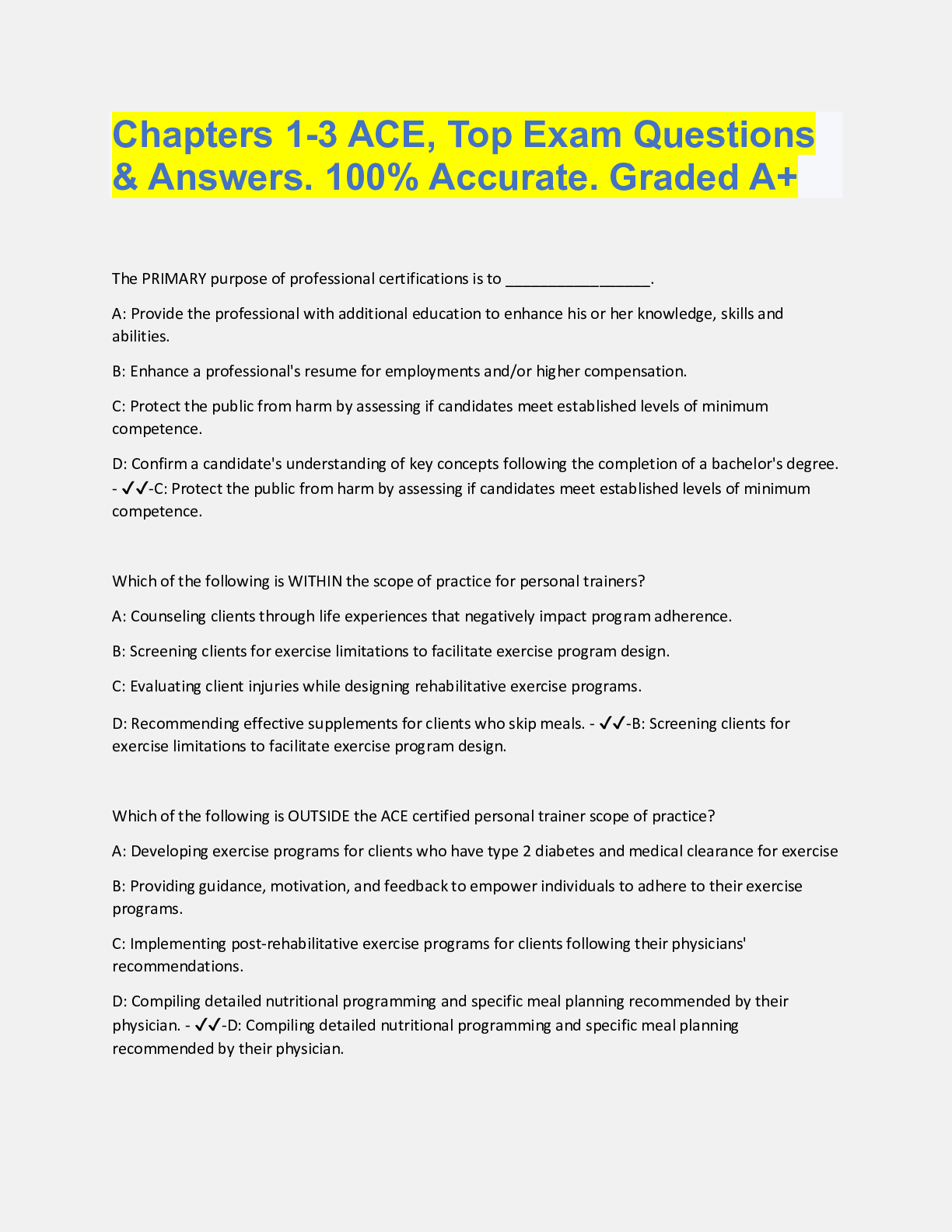
ACE FINAL Exam BUNDLE, Approved Exam predictor.
ACE FINAL Exam. Top Questions with accurate answers. 100% Verified Predictor paper. 24 exam versions.
By Topmark 2 years ago
$38
23
Reviews( 0 )
$13.00
Can't find what you want? Try our AI powered Search
Document information
Connected school, study & course
About the document
Uploaded On
Mar 14, 2023
Number of pages
111
Written in
All
Additional information
This document has been written for:
Uploaded
Mar 14, 2023
Downloads
0
Views
136

